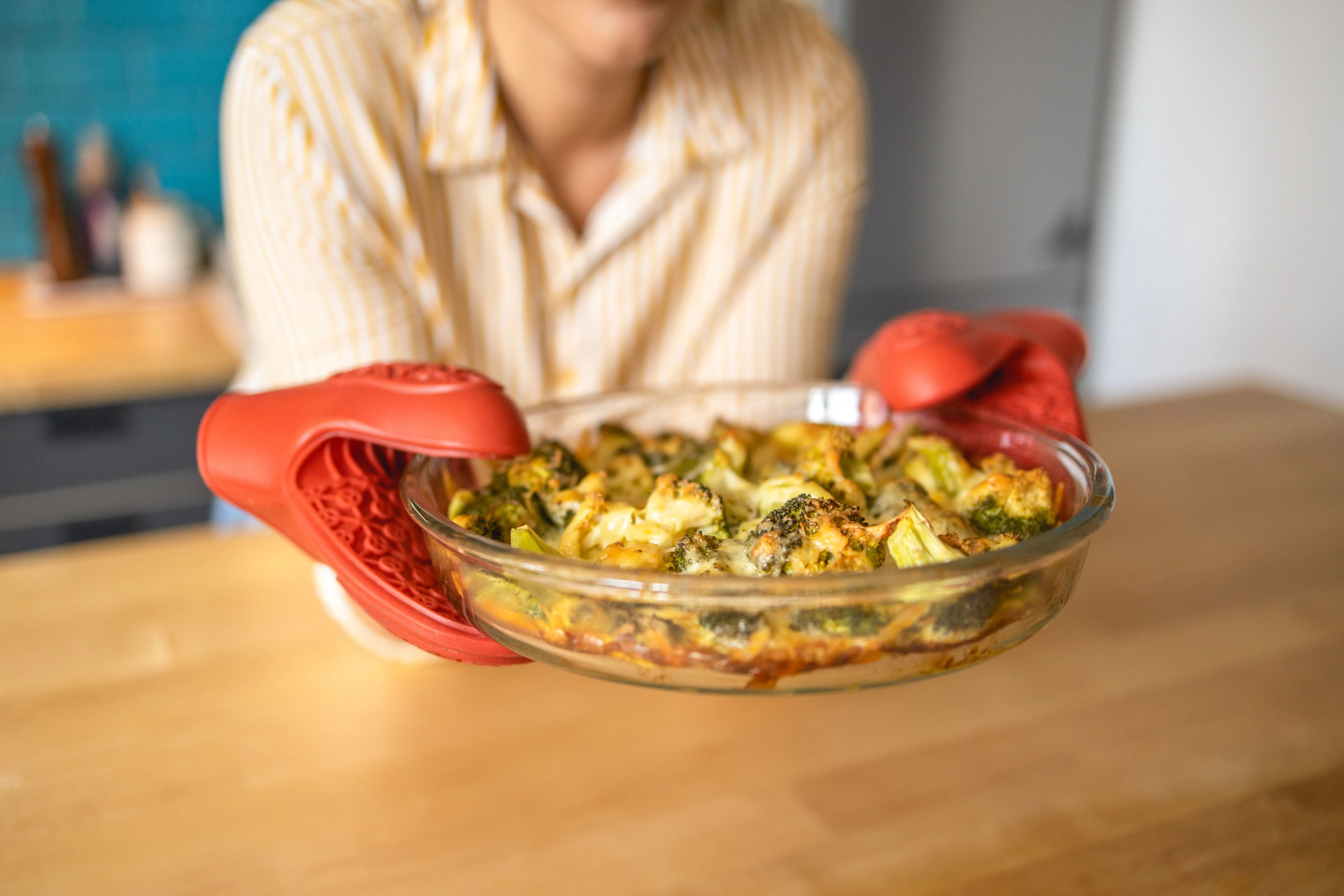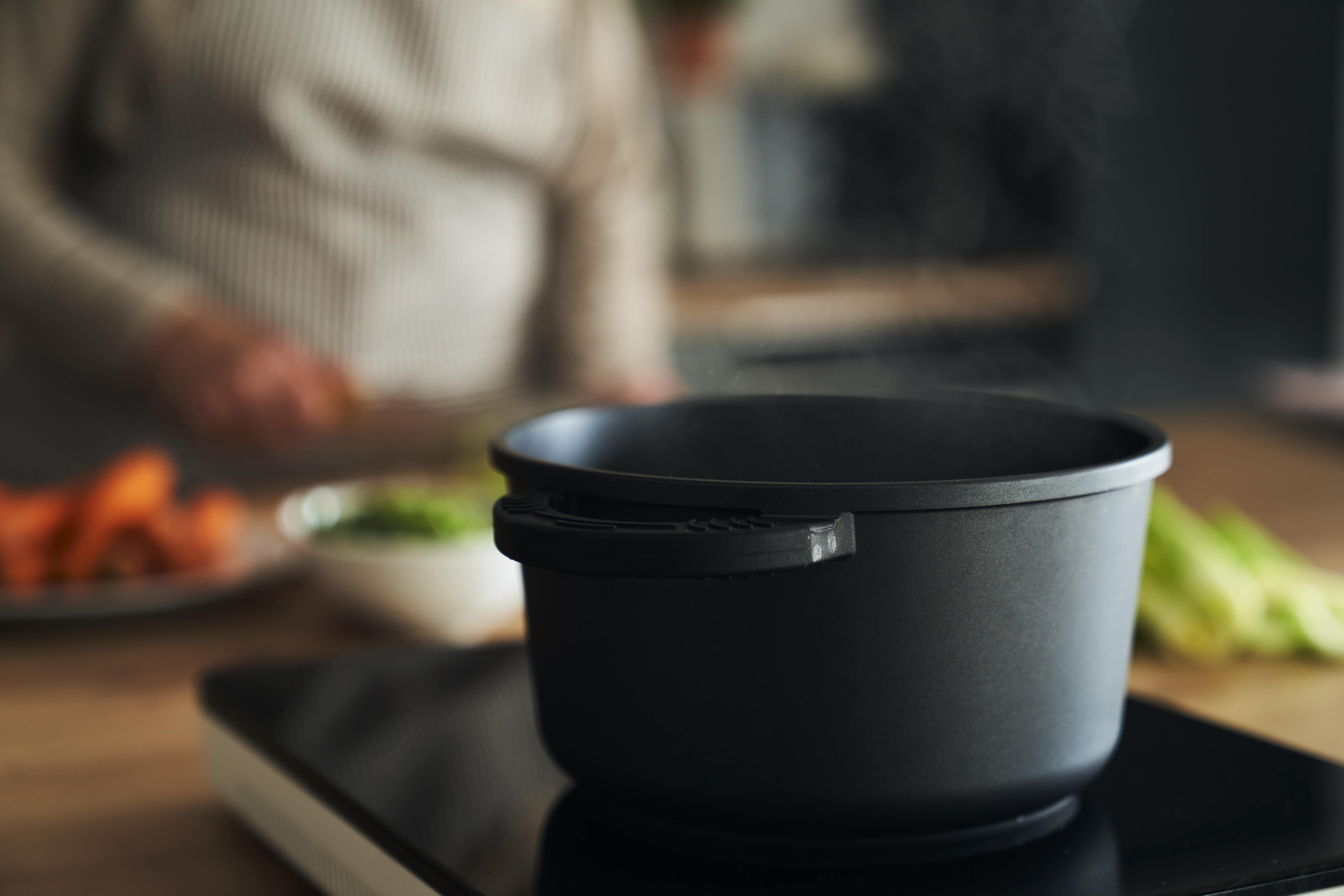Key Takeaways
- Fall comfort foods can lead to glucose spikes when made with refined carbs, heavy fats, and added sugars.
- Use fiber-rich bases, lean protein, and veggies when making fall recipes for metabolism support.
- During mealtimes, try eating fiber and protein first, followed by carbs. This helps to slow digestion and prevent blood sugar spikes.
that {{mid-cta}}
When the first chill of fall hits and your knit sweater can finally make its debut, the next order of business is comfort food: think a bubbling casserole, hearty fall soups, or warm slices of apple pie that fill your kitchen with fall flavors. Whether you’re planning a cozy fall dinner or testing new fall dinner recipes, these dishes are all about warmth and nostalgia.
But while fall is the perfect season (and excuse!) to indulge in these cozy classics, a little less comforting is realizing the amount of refined carbs and added sugars often hiding in them. From starch-heavy sauces to processed sweeteners, traditional fall dishes can send your blood sugar levels on a rollercoaster, leaving you sluggish and craving more soon after eating.
The good news is, you don't have to give up these meals, especially if you're mindful of blood sugar, or trying to make better choices for your metabolic health. In this article, we’ll share how a few strategic swaps and smarter prep can deliver the cozy fall flavor you love, without causing sharp blood sugar swings this season.
Why Comfort Foods Spike Glucose

Before you go pointing fingers at your pantry, know this: even “healthy” foods can cause your blood sugar to spike. That said, comfort foods are often the biggest offenders, thanks to the way their ingredients combine to send glucose levels climbing.
A simple fall craving, such as a pumpkin pie, comes fully loaded with refined carbs, sugars, and heavy fats. Refined carbs break down fast, flooding your bloodstream with glucose almost immediately. Add heavy fats to the mix, and your digestion slows down, not enough to prevent the spike, but just enough to prolong the process. The result? Your metabolism ends up working overtime to keep up with the demands.
The same goes for the ultimate fall comfort food: mac and cheese or creamy lasagna layered with refined noodles and a creamy sauce. Even a flaky pie crust made with brown sugar can cause a quick glucose spike. These comforting pasta recipes may taste like a hug in a bowl, but their ingredients can send your blood sugar on a rollercoaster.
Other seasonal favorites built on pastry cuts, creamy sauces, and your favorite pasta recipes can deliver the same blood-sugar spike, packing a lot of flavor but little to balance out the glucose spikes.
Metabolic Makeovers for Fall Classics

Before you toss those pumpkins and pasta plans down the trash chute, hear us out. With a few simple swaps, you can make your favorite one-pot meals, sheet pan bakes, and stovetop soups both cozy and blood-sugar-friendly. The goal? Keep that creamy sauce and comforting flavor, but balance it with fiber and high-protein ingredients that help you feel satisfied longer.
Here are recipes to give your favorite fall dishes a makeover that delivers all the flavor while skipping out on the blood-sugar crashes:
Mac & Cheese: Protein-Packed Cauli Mac
This mac and cheese makeover retains the deliciousness of the original, while incorporating extra fiber and high protein to help you stay full and energized. The Greek yogurt base also creates a naturally creamy sauce that’s higher in protein and lower in fat.
Ingredients
- 8 oz chickpea or cauliflower pasta
- ¾ cup plain Greek yogurt or ½ cup cottage cheese
- ½ cup shredded cheddar (or mix of cheddar and mozzarella)
- 1 tbsp olive oil
- ½ tsp paprika (optional, for warmth)
- 1 tsp garlic powder
- Salt and pepper to taste
- 1 cup roasted broccoli florets (as a topping)
Directions
- Cook the pasta: Boil chickpea or cauliflower pasta according to package directions. Drain and set aside.
- Make the sauce: In a small pot over low heat, whisk together Greek yogurt or cottage cheese, olive oil, garlic powder, paprika, salt, and pepper. Stir until warmed through and creamy; don’t let it boil.
- Combine: Toss the pasta with the sauce, mixing until coated and smooth. Stir in the shredded cheese until it is melted and creamy.
- Add fiber: Fold in roasted broccoli florets or top them over your bowl for extra texture and nutrients.Top with a sprinkle of parmesan for extra depth.
This one-pan meal makes an easy fall dinner or hearty side dish on a chilly night. For a baked version, transfer to a dish, sprinkle with whole-grain breadcrumbs or nutritional yeast, and broil for 3–5 minutes until golden.
Chili: High-Protein, Blood Sugar–Friendly Fall Soup
If you’re craving a hearty chili recipe for busy weeknights, this slow cooker or crockpot version is packed with flavor.
Ingredients
- 1 lb lean ground beef, turkey, or chicken
- 1 tbsp olive oil
- 1 onion, chopped
- 2 garlic cloves, minced
- 1 bell pepper or zucchini, chopped
- 1 can beans (black, kidney, or pinto), rinsed and drained
- 1 can diced tomatoes
- 1 cup low-sodium broth
- 1 tbsp chili powder
- 1 tsp cumin
- Salt and pepper
- Optional toppings: Greek yogurt, avocado, cilantro
Directions
- Sauté: Heat olive oil in a large pot over medium heat on the stovetop. Add onion and garlic; cook until fragrant.
- Add protein: Stir in beef, turkey or chicken and cook until browned.
- Add veggies and seasoning: Mix in bell pepper or zucchini, chili powder, cumin, salt, and pepper.
- Simmer: Add beans, diced tomatoes, and broth. Simmer for 20–25 minutes, or until the sauce has thickened.
- Top and serve: Finish with a dollop of Greek yogurt, avocado slices, or fresh cilantro.
Other variations: Swap the beans for white beans for a twist, or use ground beef or chicken chili for added protein.
Pumpkin Pie: Glucose-Friendly Pumpkin Custard
When it comes to fall desserts, pumpkin pie and apple cider reign supreme. For a healthier take on pumpkin pie, skip the crust and add a protein-rich topping to enjoy one of the all-time favorite fall desserts. A touch of Greek yogurt adds a secret ingredient twist: creaminess without the crash.
Ingredients
- 1 can (15 oz) pumpkin purée (not pie filling)
- 2 eggs
- ½ cup unsweetened almond milk (or milk of choice)
- ¼ cup monk fruit or stevia blend (adjust to taste)
- 1 tsp vanilla extract
- 1½ tsp pumpkin pie spice
- Pinch of salt
- Optional: ¼ cup almond flour (for a soft base or gluten-free crust substitute)
- Greek yogurt or protein-rich whipped cream for topping
Directions
- Preheat oven: Set to 350°F (175°C). Lightly grease one baking dish.
- Mix ingredients: In a large bowl, whisk together pumpkin purée, eggs, almond milk, sweetener, vanilla, spices, and salt until smooth.
- Optional crust: If you’re using almond flour, press it into the bottom of the dish before pouring in the pumpkin mixture.
- Bake: Pour mixture into dish. Bake for 35–40 minutes, or until the custard is set but slightly soft in the center.
- Cool and serve: Let cool, then top with a dollop of Greek yogurt or protein-rich whipped cream.
Casseroles: Veggie-Forward Bakes

From butternut squash to sweet potatoes and brussels sprouts, one-pot casseroles can be both satisfying and balanced. You can elevate classic casseroles by swapping heavy starches and creamy soup bases for lean protein, fiber-rich veggies, and lighter cream.
Ingredients
- 1 cup lentils (cooked) or 1 can white beans, rinsed
- 1½ cups chopped mushrooms
- 2 cups leafy greens (spinach, kale, or Swiss chard)
- 1 cup Greek yogurt or ½ cup puréed cauliflower (for the creamy layer)
- ½ cup shredded cheese (optional for topping)
- 1 tbsp olive oil
- 1 tsp garlic powder
- Salt and pepper, to taste
- Optional: whole-grain breadcrumbs or crushed nuts for crunch
Directions
- Preheat oven: Set to 375°F (190°C). Lightly grease a baking dish.
- Roast the veggies: Heat olive oil in a pan. Toss mushrooms and greens with olive oil, salt, and pepper. Spread on a sheet pan and roast at 400°F (200°C) for 10–15 minutes, until softened and lightly browned.
- Mix the base: In a large bowl, combine lentils or beans with the cooked veggies, garlic powder, salt, and pepper.
- Add creaminess: Stir in Greek yogurt or puréed cauliflower until the mixture is evenly coated.
- Assemble and bake: Transfer to the baking dish, top with shredded cheese or breadcrumbs, and bake for 20–25 minutes, until golden and bubbly.
Other variations: Try swapping lentils for quinoa or wild rice, then top with a sprinkle of parmesan or goat cheese. For a flavor boost, stir in a spoonful of pesto before baking.
Metabolic Playbook: How to Upgrade Any Comfort Food

To stay on the “new fall, new metabolism” game plan, it’s time for some upgrades, and not just in your wardrobe.
Classic comfort dishes like lasagna don’t need to disappear from your menu; they just need a smarter base. Swap refined carbs for whole-grain noodles, layer in plenty of fiber-rich vegetables, and opt for lighter cheese for a balanced hit of protein.
Whenever you can, sneak extra vegetables into your meal, whether as side dishes, tossed into hearty fall salads, or stirred into your busy weeknight dishes. They add color, texture, and nutrients that keep your plate (and your body) feeling fresh.
And as a general rule: eat your meals in the right order. Start with fat, protein, and fiber before the carbs. This simple sequence helps slow digestion, stabilize your glucose levels, and maintain consistent energy throughout the day.
The Signos Approach: Data Meets Comfort Food

Think of Signos as a looking glass into how your body truly responds to food. By tracking your glucose in real time, you can see the difference between traditional comfort dishes and their upgraded versions. Maybe classic ziti spikes your glucose, but add rotisserie chicken or roast chicken, drizzle with olive oil, and you’ll notice a steadier curve.
Your data reveals how different food combinations impact your energy and metabolism, turning every meal into actionable insight. Over time, you’ll start to see clear patterns and learn which swaps during meal planning make the biggest impact for your body. Comfort foods no longer have to feel like a guilty pleasure, but rather a personalized fuel source, helping you eat in a way that’s satisfying and balanced.
The Bottom Line
With the right swaps, your favorite cozy fall meals can fit perfectly into your fall dinner recipes lineup. From smart dinner ideas to balanced comfort food, you can enjoy every bite while keeping your metabolism steady.
Learn More With Signos Expert Advice
Understanding how your body responds to food is one of the most powerful ways to improve your overall health. Signos offers science-backed insights and expert guidance to help you make sense of your glucose data, from identifying the foods that fuel steady energy to creating habits that support long-term metabolic health. Explore how Signos can improve health and dive deeper into the science of blood sugar balance on the Signos blog.




.svg)








.webp)

.svg)
.svg)
.svg)
.svg)
.svg)
.svg)
.svg)
